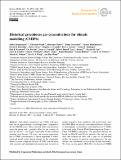Historical greenhouse gas concentrations for climate modelling (CMIP6)
Author(s)
Meinshausen, Malte; Vogel, Elisabeth; Nauels, Alexander; Lorbacher, Katja; Meinshausen, Nicolai; Etheridge, David M.; Fraser, Paul J.; Montzka, Stephen A.; Rayner, Peter J.; Trudinger, Cathy M.; Krummel, Paul B.; Beyerle, Urs; Canadell, Josep G.; Daniel, John S.; Enting, Ian G.; Law, Rachel M.; Lunder, Chris R.; Reimann, Stefan; Rubino, Mauro; Velders, Guus J. M.; Vollmer, Martin K.; Wang, Ray H. J.; Weiss, Ray; O'Doherty, Simon; Prinn, Ronald G; ... Show more Show less
Downloadgmd-10-2057-2017.pdf (15.54Mb)
PUBLISHER_CC
Publisher with Creative Commons License
Creative Commons Attribution
Terms of use
Metadata
Show full item recordAbstract
Atmospheric greenhouse gas (GHG) concentrations are at unprecedented, record-high levels compared to the last 800 000 years. Those elevated GHG concentrations warm the planet and - partially offset by net cooling effects by aerosols - are largely responsible for the observed warming over the past 150 years. An accurate representation of GHG concentrations is hence important to understand and model recent climate change. So far, community efforts to create composite datasets of GHG concentrations with seasonal and latitudinal information have focused on marine boundary layer conditions and recent trends since the 1980s. Here, we provide consolidated datasets of historical atmospheric concentrations (mole fractions) of 43 GHGs to be used in the Climate Model Intercomparison Project - Phase 6 (CMIP6) experiments. The presented datasets are based on AGAGE and NOAA networks, firn and ice core data, and archived air data, and a large set of published studies. In contrast to previous intercomparisons, the new datasets are latitudinally resolved and include seasonality. We focus on the period 1850-2014 for historical CMIP6 runs, but data are also provided for the last 2000 years. We provide consolidated datasets in various spatiotemporal resolutions for carbon dioxide (CO₂), methane (CH₄) and nitrous oxide (N₂O), as well as 40 other GHGs, namely 17 ozone-depleting substances, 11 hydrofluorocarbons (HFCs), 9 perfluorocarbons (PFCs), sulfur hexafluoride (SF₆), nitrogen trifluoride (NF₃) and sulfuryl fluoride (SO₂F₂). In addition, we provide three equivalence species that aggregate concentrations of GHGs other than CO₂, CH₄ and N₂O, weighted by their radiative forcing efficiencies. For the year 1850, which is used for pre-industrial control runs, we estimate annual global-mean surface concentrations of CO₂ at 284.3 ppm, CH₄ at 808.2 ppb and N₂O at 273.0 ppb. The data are available at https://esgf-node.llnl.gov/search/input4mips/ and www.climatecollege.unimelb.edu.au/cmip6. While the minimum CMIP6 recommendation is to use the global- and annual-mean time series, modelling groups can also choose our monthly and latitudinally resolved concentrations, which imply a stronger radiative forcing in the Northern Hemisphere winter (due to the latitudinal gradient and seasonality).
Date issued
2017-05Department
Massachusetts Institute of Technology. Department of Earth, Atmospheric, and Planetary SciencesJournal
Geoscientific Model Development
Publisher
Copernicus GmbH
Citation
Meinshausen, Malte et al. “Historical Greenhouse Gas Concentrations for Climate Modelling (CMIP6).” Geoscientific Model Development 10, 5 (May 2017): 2057–2116 © Author(s) 2017
Version: Final published version
ISSN
1991-9603
1991-959X